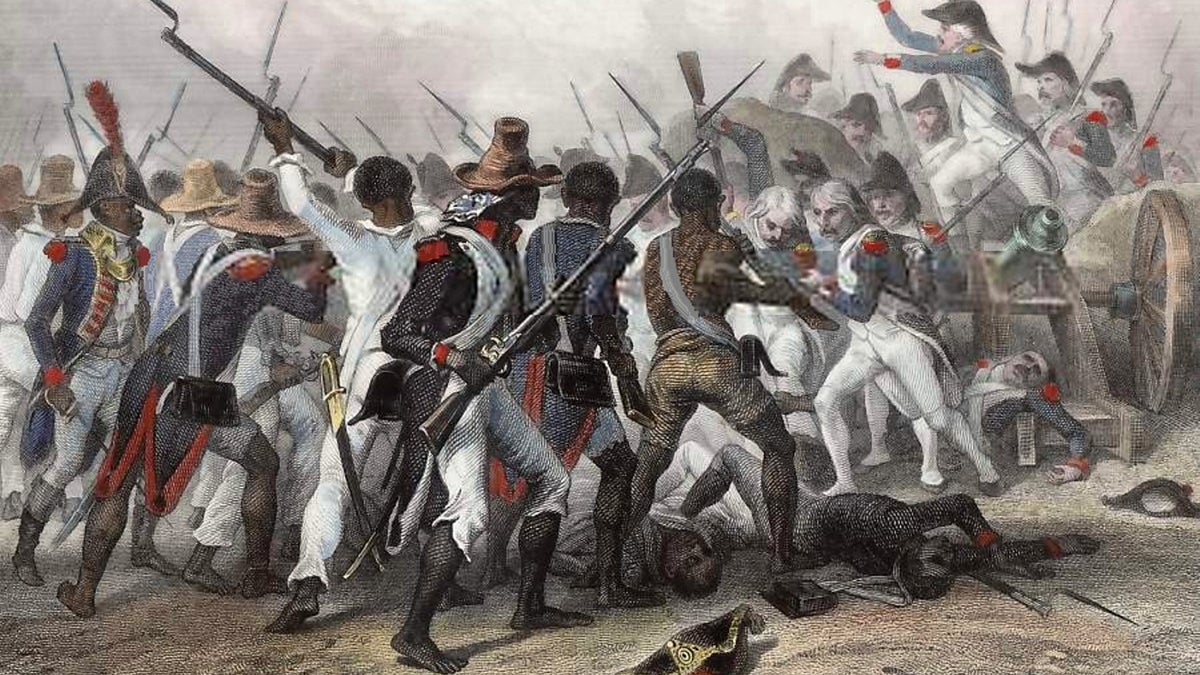White paranoia, from Denmark Vesey to Dylann Roof

Images like these, depicting the Battle of Vertières, a major battle of the Second War of Haitian Independence, fueled fears of slave rebellion in the United States. (Wikimedia Commons)
The nine African-Americans murdered at the Emanuel African Methodist Episcopal Church in Charleston, South Carolina, last week were victims of racist paranoia. And across our history, whites have imagined blacks conspiring against them.
“You rape our women, you’re taking over our country. You have to go.”
That’s what gunman Dylann Roof declared while he was murdering nine African-Americans at the Emanuel African Methodist Episcopal Church in Charleston, South Carolina, last week. Some observers speculated that Roof chose the church — and even the date of his horrific deed — because of its association with Denmark Vesey, who allegedly planned to lead a slave revolt in Charleston on June 16, 1822.
But there’s a good chance that Vesey never plotted any such revolt. He was instead the victim of racist paranoia, much like the nine African-Americans whom Dylann Roof murdered. Racism is a form of imagination, not just of domination. And across our history, whites have imagined blacks conspiring against them.
An uncommon path to freedom
That’s probably what happened to Denmark Vesey, who arrived in the United States as a teenager on a slave ship in 1781. Noticing the young man’s “alertness and intelligence,” the ship captain made Vesey his cabin boy and eventually his manservant in a well-appointed Charleston home. Vesey learned to read and write English and also spoke some French, both hallmarks of high status in South Carolina’s slave community.
But Vesey’s status changed most abruptly in 1799, when he won $1,500 in a lottery. He used $600 to purchase his freedom. Then he married a free woman of color named Susan, who was about 30 years his junior. And shortly after that, Denmark and Susan Vesey joined the African Methodist Episcopal Church.
The AME had been founded by Philadelphia’s Richard Allen, to counter the racism and condescension of white Methodists. And Charleston’s two AME congregations represented an obvious threat to white supremacy. When Allen came to preach in Charleston in 1818, 140 black congregants were arrested for violating a city ordinance against worshipping without a white person present.
But they continued to do so in private homes like the Veseys’, where Denmark occasionally preached. Given the AME’s emphasis on the Old Testament’s Exodus tale, where God frees the Israelites, it would not be surprising if Vesey used his pulpit to denounce slavery.
‘Enhanced interrogation’ yields a false positive
But it’s highly unlikely that he plotted a wide-scale rebellion against it. The charge dated to an 1822 conversation between two slaves in the Charleston Harbor, after they spotted a ship bearing a flag that referred to the recent slave revolts in Haiti. One of the slaves then told his master about the discussion, which led fearful South Carolina authorities to interrogate and torture the other slave. Was he aware of any Haitian-style rebellions afoot in South Carolina?
The anguished slave denied any such knowledge for a week, but broke after his torturers threatened to hang him. Yes, he finally said, there was a plot. But its leader was a conjurer who possessed a charm that made him “invulnerable,” the slave said.
The authorities then interrogated several other blacks in Charleston, who initially implicated one of the state governor’s slaves. One informant said that the governor’s slave planned to march on Charleston with an army of 4,000 and “kill all the whites.” And “when we have done with the fellows,” the plotter was reported to have said, “we know what to do with the wenches.”
Nobody remarked on the contradiction between these two testimonies: If the plan was to kill all the whites, how could the women be raped as well? In charging that “you” — that is, you blacks — rape white women, likewise, Dylann Roof doesn’t seem to have noticed that six of his nine victims were female, not male. That’s racism for you: building on fear and fantasy, it discounts reason and reality.
The church, a symbol of freedom, resurrection
We still don’t know how South Carolina officials found their way to Denmark Vesey, because he was tried in secret. But at least one slave told authorities that he heard Vesey speak of a “large army from St. Domingo [that is, Haiti] and Africa,” which gives you a sense of the wild tales that were spun around him.
Indeed, the story of Denmark Vesey embodied almost every deep fear in the racist white mind. There’s Haiti, site of the biggest slave revolt in the New World. There’s a free man of color, who by his very independence threatens white supremacy.
Then there’s the African Methodist Episcopal Church. After Vesey and 34 other alleged conspirators were hanged, the AME church that he attended was burned to the ground. Revived after the Civil War, it was destroyed in an earthquake in 1891 and then rebuilt yet again.
And it retained its status throughout as a symbol of black freedom, which might be why Dylann Roof targeted it last Wednesday. Like Denmark Vesey’s tormentors, he believed that African-Americans were plotting wanton violence against white people. For most of our history, of course, it’s been precisely the opposite. But in the racist imagination, blacks are always just a heartbeat from domination. They’re taking over the country. And they have to go.
WHYY is your source for fact-based, in-depth journalism and information. As a nonprofit organization, we rely on financial support from readers like you. Please give today.

